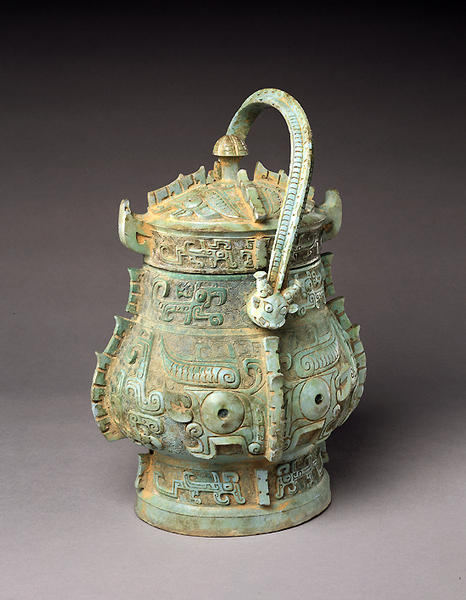Wine Vessel: You
- China, probably Henan province
- Late Shang period, middle or late Anyang phase
- about 1200 - 1050 B.C.
- Bronze
- H-32 D-22 W-25.1
Catalogue Entry
At ancient ritual Chinese banquets offered to esteemed deceased ancestors, wine kept in imposing containers like this example was probably been ladled into warming tripods before being consumed, symbolically or actually, by the spiritual or mortal participants in the rite. Given this function, such ritual bronzes were highly prized possessions in antiquity.
Representing a vessel type that appeared relatively late in the Anyang period (about 1300-1050 B.C.), this you1 exemplifies the continued creativity of Shang bronze designers.2 Borrowing aspects from other kinds of ritual wine containers, bronze-casters created a hybrid vessel that related to two types with longer histories. The flattened oval body recalls the shape of the elliptical hu (a more attenuated, unlidded wine vessel), while the bail handle and its position--spanning the short axis of the container--and the curious beak-like projections from the sides of the lid reflect a type of earlier you that took the form of a pair of owls standing back to back. The different orientations of the primary relief masks on the lid and body attest to these diverse origins. On the lid, the contracted staring faces occupy the places formerly filled by owl heads on the back-to-back you. The beaks, relevant to owls but inexplicable elements on bovine masks, are preserved on the Shumei you, presumably for decorative effect. More elaborate masks, related to those on the lid, are on the body. Here, they adhere to the central axis on the broad flanks of the vessel. This axis also serves as the focus of all secondary relief motifs in the narrow registers of the body above and below. The design of projecting flanges extend the subdivisions of the decorated surface to the vessel profile.
Archaeologically recovered examples like this you have been found in tombs datable to the last century or so of the Anyang period.3 Strangely, the type did not survive long into the subsequent Western Zhou period (about 1050-771 B.C.): within the first century of the new dynasty, it was replaced by a kind of you with a handle spanning the long axis of the vessel, affecting the design of the vestigial beaks on the lid.4
Like all Shang bronzes, the Shumei you was manufactured using decorated clay piece-molds assembled around a clay core. Both the lid and body appear to have been cast in a four-division mold assembly, the sections of the mold corresponding with the vertical flanges. On vessels of this type, the handles were precast or cast on. In either case, it was locked over knobs projecting from the shoulder of the vessel.5 Neither body nor lid is inscribed, indicating that their casting cores were devoid of markings. The core used to create the hollow ring foot, however, was incised with a reptilian pattern that left a design in thin raised lines on the bottom of the vessel. The meaning and purpose of this and related relief patterns are unknown.
JKW
1. Although no Shang vessels of this type bear inscriptions naming them you, the term has designated this shape since the Song dynasty; see Hayashi 1984, vol. 1, pp. 70-71. The original function of such vessels is, in fact, also unclear, but the name is used to designate measures of wine in the famous early Western Zhou inscribed tripod, Da Yu ding.
2. See Bagley 1987, pp. 373-77.
3. With a few notable exceptions such as a you now in the Worcester Art Museum (no. 1940.18), believed to come from a middle or late Anyang burial, and a late Anyang you from Hui Xian, Henan (see Wenwu 1979.7, p. 79), most related vessels come from locations outside Anyang; see for example, Kaogu 1963.12, p. 646-47, for a late Anyang vessel excavated at Ningxiang, Hunan province.
4. See Rawson 1990, pp. 515-22.
5. Gettens 1969, pp. 88-92.
